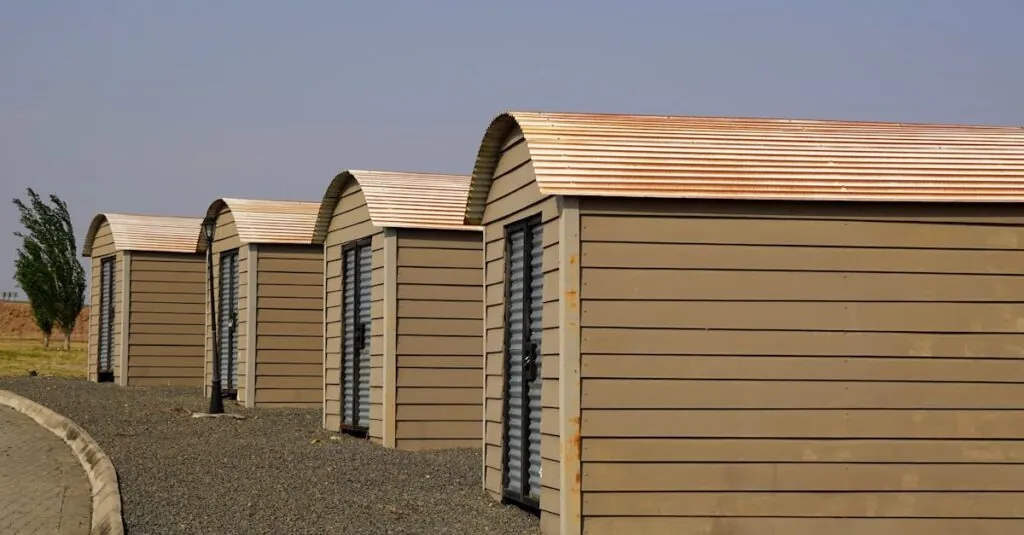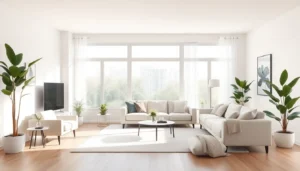In a world where homes can pop up faster than a microwave meal, modular housing is leading the charge in innovative living solutions. But wait—before you grab your toolbox and start building your dream home in the backyard, it’s crucial to navigate the maze of regulations that come with it. Think of them as the quirky rules of a game that could determine whether your new abode is a cozy haven or a construction site nightmare.
Table of Contents
ToggleOverview of Modular Housing Regulations
Modular housing regulations vary significantly across jurisdictions. Each state, county, and city implements specific building codes and zoning laws that govern modular homes. Compliance with these standards is essential for obtaining permits, which include inspections during the construction process.
State regulations often dictate the structural requirements for modular units. Local governments might establish additional guidelines that affect design, aesthetics, and even placement of the homes within communities. Adhering to these regulations ensures that modular homes align with the character of existing neighborhoods.
Inspections play a crucial role in the regulation process. Various stages, including foundation, framing, and utility installation, require approval from local authorities. Homeowners cannot proceed to the next phase without passing these inspections.
Manufacturers must comply with national standards for safety and quality. The International Code Council (ICC) provides guidelines that many municipalities adopt. Following these standards helps to mitigate potential hazards and ensures homes are safe for occupants.
Licensing becomes necessary for manufacturers and builders in many areas. Contractors often require specific certifications, which demonstrates their capability to construct modular homes per regulations. Engaging with licensed professionals promotes a smoother construction process and adherence to all regulatory requirements.
Understanding these regulations remains vital for prospective homeowners and builders alike. Researching local laws and engaging with planning departments can prevent potential setbacks. Modular housing presents innovative opportunities, but navigating the accompanying regulations ensures a successful construction experience.
Key Components of Modular Housing Regulations
Understanding modular housing regulations requires familiarity with key components like building codes and zoning laws, which significantly affect the construction process.
Building Codes
Building codes ensure safety and quality within the construction of modular homes. These codes stipulate requirements for structural integrity, materials, and construction techniques. Compliance with standards set by the International Code Council (ICC) is crucial for manufacturers and builders. Local jurisdictions may impose additional regulations, requiring attention to detail in compliance efforts. Modifications may arise from state and municipal codes, hence it’s important for builders to stay informed about local amendments. Adhering to these codes helps secure necessary permits, allowing for efficient progression through construction phases.
Zoning Laws
Zoning laws dictate where modular homes can be located and how they fit into existing communities. These laws influence land use, density, and overall aesthetics. Different zones may have specific requirements for design, setbacks, and occupancy. Builders and homeowners must consult local zoning ordinances to avoid potential conflicts. Engaging with local planning departments ensures compliance with zoning rules, leading to smooth project execution. Special conditions may apply in mixed-use developments, requiring careful consideration. Proper navigation of zoning laws prevents delays and enhances community integration.
Benefits of Modular Housing
Modular housing offers multiple advantages, significantly impacting home ownership, environmental sustainability, and overall quality of life.
Affordability
Affordability stands out as a primary benefit of modular housing. Lower construction costs arise from efficient factory production processes and reduced labor expenses. Buyers often find modular homes priced 10% to 20% lower than traditional homes. Financial accessibility expands, allowing more individuals and families to achieve home ownership. Reduced construction times also lead to earlier occupancy, enabling buyers to save on temporary housing costs. Additionally, energy-efficient designs enhance long-term savings on utility bills, further improving affordability for homeowners.
Sustainability
Sustainability plays a significant role in the appeal of modular housing. Eco-friendly materials often feature in construction, minimizing environmental impact during the building process. Modular homes typically result in less waste, as factories can recycle materials effectively. Energy-efficient designs frequently incorporate sustainable features, including solar panels and high-quality insulation. Many modular buildings achieve certifications like LEED for their energy-efficient practices. Ultimately, modular housing contributes to a reduced carbon footprint, making it an attractive choice for environmentally conscious buyers.
Challenges in Implementing Regulations
Navigating the regulatory landscape of modular housing presents significant challenges. Compliance issues often arise as varying building codes and zoning laws create confusion for builders.
Compliance Issues
Compliance issues frequently stem from differing state and local regulations. Builders encounter obstacles when attempting to meet multiple codes, which may compromise efficiency during construction. Inspections at each phase require adherence to strict standards set by the International Code Council (ICC), and failing inspections can delay project timelines. For instance, certain jurisdictions may mandate additional compliance beyond basic federal requirements, complicating the process further. Builders must invest time in researching specific local standards to avoid costly setbacks and ensure timely completion.
Public Perception
Public perception complicates the acceptance of modular housing. Some individuals view modular homes as inferior or temporary solutions, leading to skepticism about quality and safety. Overcoming these misconceptions requires education and awareness. Demonstrating successful modular projects and sharing testimonials can foster trust within communities. Additionally, addressing concerns about aesthetics will help integrate modular homes into neighborhoods positively. Engaging local residents in discussions about benefits will improve acceptance and pave the way for more supportive regulations.
Future Trends in Modular Housing Regulations
Stricter regulations are likely to emerge as the popularity of modular housing grows. Many jurisdictions are already examining how to update existing laws to reflect this construction method. States may adopt unified building codes, simplifying compliance and fostering consistency for builders. Anticipated changes could make modular construction more appealing by streamlining the permit process.
Energy efficiency standards are set to increase, emphasizing sustainability in new modular housing. Regulations may eventually require builders to incorporate renewable energy sources like solar panels. Transitioning to energy-efficient designs aligns with the global push for eco-friendly living.
Zoning laws will evolve to better accommodate modular homes within varied communities. Conversations about mixed-use developments are becoming more common, allowing modular units to coexist with traditional housing. Engagement with local planning departments will grow essential for builders to position their projects effectively.
Public awareness campaigns can improve perceptions of modular homes. As more homeowners understand the advantages, including affordability and sustainability, acceptance may rise. Homeowners and builders might benefit from collaborative initiatives, showcasing successful modular projects in communities.
Licensing requirements for builders and contractors could strengthen, ensuring adherence to quality standards. Compliance with new federal guidelines may complement existing local regulations, creating a more robust framework. Increased training opportunities for builders may arise in response to evolving standards, promoting best practices within the industry.
Innovation in materials will influence future modular housing regulations. As new technologies develop, regulations may adapt to include advanced construction techniques and materials. This shift could encourage manufacturers to explore sustainable options, further enhancing modular housing’s appeal.
Navigating modular housing regulations is essential for anyone looking to build or invest in this innovative housing solution. Understanding the varied building codes and zoning laws can significantly influence the construction process and overall success. As the modular housing market continues to grow, staying informed about evolving regulations will be crucial.
By engaging with local authorities and adhering to compliance standards, builders and homeowners can streamline their projects and avoid potential setbacks. Embracing the benefits of modular homes while addressing regulatory challenges will pave the way for a more sustainable and affordable future in housing.





